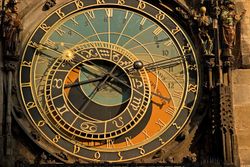Difference between revisions of "Category:1450s"
| Line 64: | Line 64: | ||
* [[Storie sacre (1475c Tornabuoni), poetry]] | * [[Storie sacre (1475c Tornabuoni), poetry]] | ||
== Overview (1450s) == | |||
After the ''editio princeps'' of the Latin Bible (including the [[OT Apocrypha]] and the [[New Testament]]) by [[Johannes Gutenberg]] in 1452-55, the study of Second Temple Judaism and Christian Origins began with the publication of the Latin text of [[Josephus]] (1470) and the Hebrew text of [[Josippon]] (1474-76). Christian Cabalists, like [[Giovanni Pico della Mirandola]] and [[Johannes Reuchlin]], began emphasizing the importance of "post-biblical" Jewish (and Islamic) literature as a source for recovering the primeval wisdom of Enoch. | After the ''editio princeps'' of the Latin Bible (including the [[OT Apocrypha]] and the [[New Testament]]) by [[Johannes Gutenberg]] in 1452-55, the study of Second Temple Judaism and Christian Origins began with the publication of the Latin text of [[Josephus]] (1470) and the Hebrew text of [[Josippon]] (1474-76). Christian Cabalists, like [[Giovanni Pico della Mirandola]] and [[Johannes Reuchlin]], began emphasizing the importance of "post-biblical" Jewish (and Islamic) literature as a source for recovering the primeval wisdom of Enoch. | ||
| Line 70: | Line 70: | ||
For the first time Second Temple Jewish subjects inspired literary works by authors like [[Feo Belcari]], [[Antonio Cornazzano]], [[Lucrezia Tornabuoni]] and her son [[Lorenzo de' Medici]]. | For the first time Second Temple Jewish subjects inspired literary works by authors like [[Feo Belcari]], [[Antonio Cornazzano]], [[Lucrezia Tornabuoni]] and her son [[Lorenzo de' Medici]]. | ||
== Interpreters == | |||
<gallery> | <gallery> | ||
Revision as of 11:13, 30 July 2023
Highlights (1450s)
1450s
1470s
- De antiquitate Judaica. De bello Judaico (1470 Schüssler), book (ed. princeps - Latin)
- ספר יוסיפון (Josippon / 1474-76 Conat), book (Hebrew / ed. princeps)
- Storie sacre (1475c Tornabuoni), poetry
Overview (1450s)
After the editio princeps of the Latin Bible (including the OT Apocrypha and the New Testament) by Johannes Gutenberg in 1452-55, the study of Second Temple Judaism and Christian Origins began with the publication of the Latin text of Josephus (1470) and the Hebrew text of Josippon (1474-76). Christian Cabalists, like Giovanni Pico della Mirandola and Johannes Reuchlin, began emphasizing the importance of "post-biblical" Jewish (and Islamic) literature as a source for recovering the primeval wisdom of Enoch.
For the first time Second Temple Jewish subjects inspired literary works by authors like Feo Belcari, Antonio Cornazzano, Lucrezia Tornabuoni and her son Lorenzo de' Medici.
Interpreters
<gallery> File:Giovanni Pico della Mirandola.jpg|thumb|left|150px|Giovanni Pico della Mirandola File:Lucrezia Tornabuoni.jpg|thumb|left|150px|Lucrezia Tornabuoni File:Johannes Gutenberg.jpg|thumb|150px|Johannes Gutenberg File:Lorenzo Medici.jpg|thumb|150px|Lorenzo de' Medici </gsllery>
Pages in category "1450s"
The following 34 pages are in this category, out of 34 total.
'
- Apocalyptic Studies (1450s)
- Archaeology (1450s)
- Bible Studies (1450s)
- Christian Origins Studies (1450s)
- Early Christian Studies (1450s)
- Early Islamic Studies (1450s)
- Early Jewish Studies (1450s)
- Enochic Studies (1450s)
- Gospels Studies (1450s)
- Hebrew Bible Studies (1450s)
- Hellenistic-Jewish Studies (1450s)
- Historical Jesus Studies (1450s)
- Johannine Studies (1450s)
- Josephus Studies (1450s)
- New Testament Studies (1450s)
- NT Apocrypha Studies (1450s)
- OT Apocrypha Studies (1450s)
- Pauline Studies (1450s)
- Petrine Studies (1450s)
- Second Temple Studies (1450s)
- Wisdom Studies (1450s)
- Women's & Gender Studies (1450s)
Media in category "1450s"
This category contains only the following file.
- 1492 * Soncino.jpg 772 × 1,024; 207 KB



